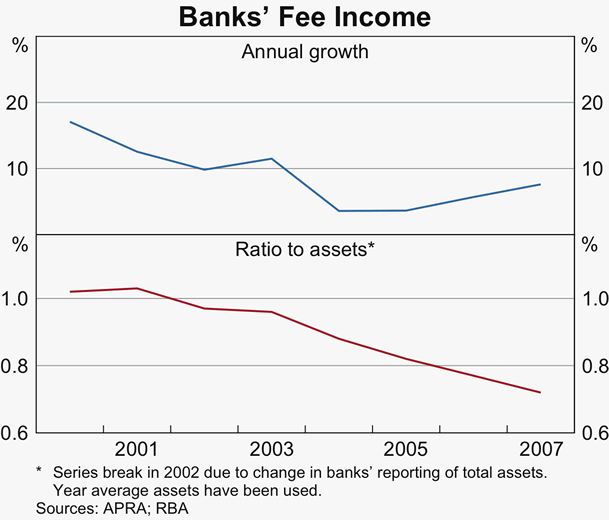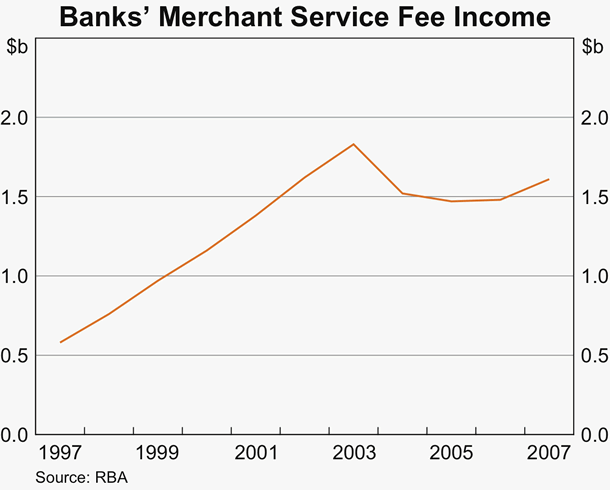Bulletin – May 2008 Banking Fees in Australia
- Download 46KB
Since 1997 the Reserve Bank has conducted an annual survey of the fees that commercial banks earn from their Australian banking operations.[1] This article summarises the results of the latest survey, relating to banks’ 2007 financial year. It covers 19 institutions that account for around 90 per cent of the total assets of the Australian banking sector.
Fees from Banking Activities
Total domestic fee income of participant banks grew by 8 per cent in 2007 to $10.5 billion, with fee income from households growing faster than fee income from businesses (Graph 1, Table 1). This rate of increase was a little higher than in the three previous years, but below the 13 per cent average annual growth rate seen between 2000 and 2003. As has been the case since 2001, the growth in fee income was slower than the growth in banks' balance sheet assets, resulting in the ratio of fee income to assets falling to 0.7 per cent.

| Business | Households | Total | ||||||||
|---|---|---|---|---|---|---|---|---|---|---|
| $ million | Annual change Per cent |
Share of total Per cent |
$ million | Annual change Per cent |
Share of total Per cent |
$ million | Annual change Per cent |
|||
| 2000 | 4,164 | 15 | 67 | 2,083 | 22 | 33 | 6,247 | 17 | ||
| 2001 | 4,797 | 15 | 68 | 2,234 | 7 | 32 | 7,030 | 13 | ||
| 2002 | 5,099 | 6 | 66 | 2,620 | 17 | 34 | 7,720 | 10 | ||
| 2003 | 5,560 | 9 | 65 | 3,047 | 16 | 35 | 8,607 | 11 | ||
| 2004 | 5,499 | −1 | 62 | 3,415 | 12 | 38 | 8,915 | 4 | ||
| 2005 | 5,584 | 2 | 60 | 3,655 | 7 | 40 | 9,239 | 4 | ||
| 2006 | 5,740 | 3 | 59 | 4,023 | 10 | 41 | 9,763 | 6 | ||
| 2007 | 6,130 | 7 | 58 | 4,376 | 9 | 42 | 10,506 | 8 | ||
|
Source: RBA |
||||||||||
Businesses
Banks' fee income from businesses rose by 7 per cent to $6.1 billion in 2007 (Table 2). This is a faster pace than over the previous five years, when fees rose at an average annual rate of 4 per cent.
| 2004 | 2005 | 2006 | 2007 | Growth 2007 Per cent |
Average growth 2001–2006 Per cent |
|
|---|---|---|---|---|---|---|
| Deposits | 740 | 758 | 761 | 775 | 2 | 3 |
| Loans | 1,485 | 1,556 | 1,613 | 1,686 | 5 | 5 |
| Merchant service fees | 1,516 | 1,468 | 1,481 | 1,606 | 8 | 1 |
| Bills | 1,120 | 1,151 | 1,224 | 1,377 | 12 | 3 |
| Other | 639 | 651 | 662 | 686 | 4 | 7 |
| Total | 5,499 | 5,584 | 5,740 | 6,130 | 7 | 4 |
|
Source: RBA |
||||||
Bank bill fee income, which includes charges for arranging bank bill facilities and accepting or endorsing bank bills, increased by 12 per cent over 2007. This mainly reflected strong growth in bank bill issuance. Fee income from business loans increased by 5 per cent, the same pace as the past few years, despite business credit increasing strongly over the period.
Fee income from business deposit accounts was little changed in 2007. Account servicing fee income decreased, offset by increases in transaction and other fees. Fee income from large business deposit accounts fell slightly, with competition between financial institutions holding down fees.
Merchant service fees, which are charged to merchants for providing credit and debit card transaction services, rose by 8 per cent in 2007 having fallen over the previous two years. Merchant service fees on credit card transactions grew modestly, with falls in average merchant service fees partially offsetting growth in the value of credit card purchases. Merchant service fees on debit cards increased more sharply, albeit from a low base, reflecting higher unit fees on EFTPOS transactions.[2] The total value of merchant service fees fell significantly after the RBA's credit card interchange fee reforms were introduced in late 2003 and, despite the substantial increases in transaction values since then, it remains below the 2003 peak (Graph 2).

Households
Banks' fee income from households increased by 9 per cent to $4.4 billion in 2007 (Table 3). Fees on deposit accounts are the largest component of banks' household fee income, accounting for 40 per cent of the total. Fee income on deposits grew by 5 per cent in 2007, below the average growth of the past few years. The growth mainly reflected increases in the number of accounts and transactions.
| 2004 | 2005 | 2006 | 2007 | Growth 2007 Per cent |
Average growth 2001–2006 Per cent |
|
|---|---|---|---|---|---|---|
| Loans: | ||||||
| – Housing | 784 | 771 | 834 | 899 | 8 | 11 |
| – Personal | 393 | 425 | 489 | 557 | 14 | 13 |
| – Credit cards | 761 | 899 | 1,021 | 1,146 | 12 | 25 |
| Deposits | 1,410 | 1,479 | 1,611 | 1,695 | 5 | 9 |
| Other fees | 68 | 81 | 68 | 79 | 16 | −9 |
| Total | 3,415 | 3,655 | 4,023 | 4,376 | 9 | 12 |
|
Source: RBA |
||||||
Fee income from housing loans grew by 8 per cent in 2007, a little faster than the growth in the number of housing loans. This partly reflects the wider take-up of housing loan packages, which have a sizeable annual fee but give households a lower interest rate on their home loans and other benefits such as fee-free deposit and credit card accounts. It also reflects higher fees associated with loan origination (and fewer waivers on these fees). Fee income from personal loans rose by 14 per cent, which was consistent with the strong growth in personal credit.
Total fees paid by households on credit cards increased by 12 per cent in 2007. Account servicing fees rose by 11 per cent, due to an increase in the number of cards and an increase in the annual fees on some credit cards (Table 4). Transaction fees (such as cash advance fees) rose by 4 per cent, consistent with there having been no increases in unit fees. Other fees on credit cards – which are mainly late payment fees, over-limit fees and foreign currency conversion fees – increased by 16 per cent. The increase appears to largely reflect a greater incidence of charges, rather than higher unit charges; the major banks' average foreign exchange conversion fees, late payment and over-limit fees were little changed in 2007.
| 2002 | 2003 | 2004 | 2005 | 2006 | 2007 | |
|---|---|---|---|---|---|---|
| Annual fees ($)(b) | ||||||
| – No-frills cards | .. | .. | .. | 38 | 41 | 48 |
| – Standard cards | 25 | 27 | 28 | 28 | 28 | 29 |
| – Standard rewards-based cards | 61 | 76 | 85 | 85 | 85 | 85 |
| – Gold rewards-based cards | 98 | 128 | 128 | 134 | 140 | 140 |
| Cash advance fees(c) | ||||||
| Own Bank's ATM ($) | 1 | 1.4 | 1.4 | 1.4 | 1.4 | 1.4 |
| – Per cent of value | 0.8 | 0.8 | 1.1 | 1.1 | 1.1 | 1.1 |
| Other Bank's ATM ($) | 1.6 | 1.6 | 1.6 | 1.6 | 1.6 | 1.6 |
| – Per cent of value | 0.8 | 1.1 | 1.4 | 1.4 | 1.4 | 1.4 |
| Overseas ATM ($) | 3.9 | 3.6 | 3.6 | 3.6 | 3.6 | 3.6 |
| – Per cent of value | 0.8 | 1.1 | 1.4 | 1.4 | 1.4 | 1.4 |
| Foreign currency conversion fee (per cent of value) |
1 | 1.3 | 1.5 | 2.4 | 2.4 | 2.5 |
| Late payment fee ($) | 21 | 23 | 29 | 29 | 31 | 31 |
| Over-limit fee ($) | 13 | 25 | 28 | 29 | 30 | 30 |
|
(a) Simple average fees for credit cards with interest-free periods issued
by major banks, except for the annual fee on no-frills cards, which is
based on a wider sample of banks. Note that changes in the sample affect
the average fee.
Sources: Cannex; RBA |
||||||
Over the past five years, fee income from credit cards has grown by 170 per cent. This mainly reflects strong growth in unit fees (particularly annual fees, over-limit and late payment fees and foreign currency conversion fees), but also a 30 per cent increase in the number of credit card accounts and a 20 per cent increase in the value of cash advances. However, the impact of the higher fees on households has been somewhat offset by the rise of no-frills cards, which have much lower interest rates than standard cards.
Other fees from households increased strongly owing to an increase in foreign currency fees such as those for travellers' cheques, but these account for less than 2 per cent of total household fees.
Conclusion
As has been the case for a number of years, banks' domestic fee income grew slower than their balance sheet assets in 2007. For both businesses and households, the growth in fee income appears to have been mainly the result of greater use of banking services, rather than higher unit charges.
Footnotes
The focus of the survey is fee income earned by banks in the process of taking deposits, making loans and providing payment services. Other forms of non-interest income, such as from funds management and insurance operations, are excluded from the survey. The survey relates to fee income earned by each participant bank over the course of their respective financial years. The data from the survey are published in RBA Bulletin Table F.6. [1]
Following reform of the EFTPOS system in November 2006, EFTPOS merchant service fees increased in response to reductions in interchange fees. See Payments System Board Annual Report 2007. [2]